The daisy flower is a perennial favourite of gardeners around the world for its bright and cheerful petals that come in various shades.
Apart from providing exquisite beauty to any garden, this easy-to-care flower can also become an integral part of your pollinator garden project due to its high nectar production capacity!
If you’re wondering how to grow these gorgeous blooms at home but are intimidated by seemingly complex gardening tasks, then this post is definitely worth a read – we will walk you through all of the necessary steps involved in planting, growing, and caring for daisies so that even beginners can get a beautiful display of colourful flowers.
Whether you want them for aesthetic purposes or as food sources for beneficial insects like honey bees, let’s now dive into the fascinating world of growing daisies!
What Are Daisies?
Daisies are flowering plants belonging to the Asteraceae family.
In addition, there are many other varieties of daisies such as Shasta daisies, African daisies, and Gerbera daisies that are popular amongst gardeners for their colourful and long-lasting blooms.
6 Types of Daisies
- English Daisy (Bellis perennis): This cheerful species is native to Europe and blooms from early spring to late fall in mild temperatures. It produces low-growing rosettes of dark green leaves that are covered with bright white petals that have yellow centres.
- Shasta Daisy (Leucanthemum x superbum): This popular perennial is a hybrid of the English Daisy and oxeye daisy. The flowers are usually white, but they can also be pink or cream-coloured.
- African Daisy (Dimorphotheca sinuata): Native to South Africa, this species grows in flat clusters of 4-inch circular blooms with yellow centres and willow-like petals.
- Pink Daisy (Osteospermum): This daisy species, also called the African daisy, grows in gardens and meadows across southern
- Europe and Africa. It produces bright five-petal blooms in shades of pink, white, purple and yellow.
- Gerbera Daisy (Gerbera jamesonii): This species is a member of the sunflower family and produces stunning, vibrant blooms in shades of orange, red and yellow.
Mexican Daisy (Erigeron karvinskianus): This low-growing daisy is native to Mexico but can be found in gardens around the world.
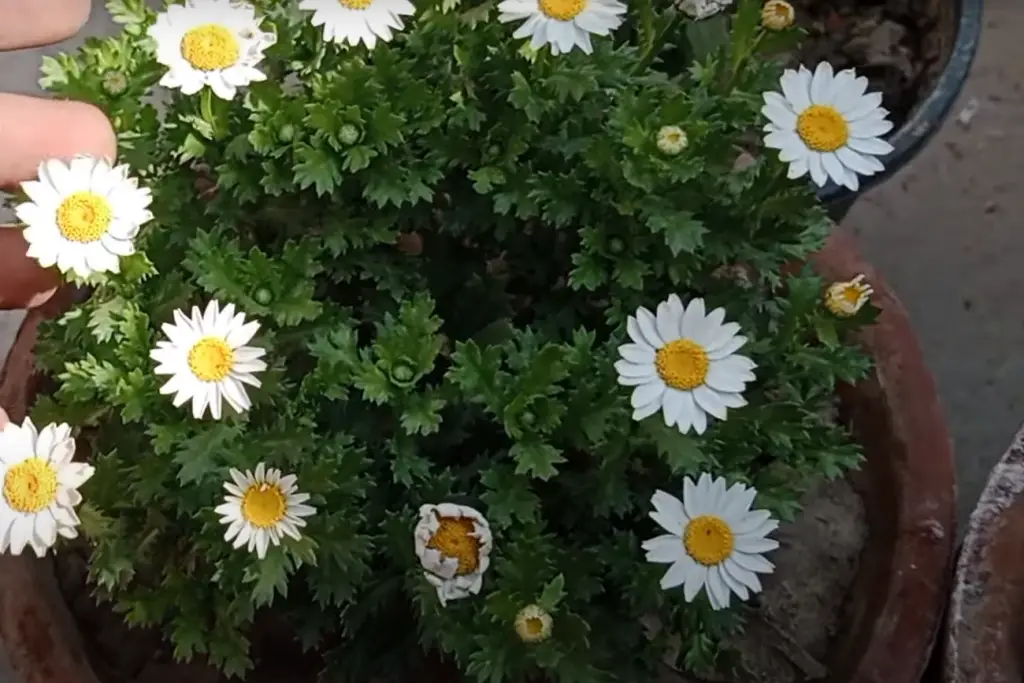
It produces long stems of small white petals with yellow centres. [1]
How to Plant Daisies From Seed
Although daisies are relatively easy to grow, they can be a bit tricky to start from seed. To ensure success when planting your own daisy garden, here are some helpful tips:
- Start by selecting the type of daisy you want to plant and purchase seeds accordingly.
- Choose a site for your daisies that is sunny and well-drained.
- Prepare the soil by loosening it with a rake or shovel and mix in some compost if needed.
- Sow your daisy seeds about ¼ inch deep and cover them lightly with soil. Water thoroughly after sowing.
- Thin plants as they grow, leaving space for larger varieties to spread out.
- Water your daisies regularly, giving them about an inch of water per week if there is no rain.
How to Plant Daisies From Root Balls
If you want to avoid the hassle of starting your daisies from seed, you can purchase pre-grown root balls from nurseries. Here’s what you need to know about planting them:
- Select a spot for your daisies that receives full sun and is well-drained.
- Dig a hole that is twice the size of the root ball and fill it with compost.
- Place your daisy plant in the hole, making sure that its roots are covered.
- Fill in around the roots with soil and press down firmly.
- Water thoroughly after planting to help settle the soil and get rid of any air pockets.
- Mulch the area with a few inches of organic mulch to conserve moisture and discourage weeds.
- Water your daisies regularly, giving them about an inch of water per week if there is no rain.
How to Care for Daisies in Your Garden
Once your daisies are established in the garden, they require very little maintenance. Here are some tips for keeping them healthy:
- Fertilise your daisies every few months with a balanced fertiliser to encourage more blooms.
- Deadhead spent flowers on a regular basis to prevent self-seeding and promote new growth.
- Protect your daisies from heavy rains and strong winds by staking them or providing some shelter.
- Check for signs of pests such as aphids, slugs, and snails and take appropriate measures to get rid of them.
- Water the plants regularly throughout the season if there is no rain so that they don’t dry out.
- In cold climates, cover your daisies with a layer of mulch in winter to protect them from frost.
Soil Composition and pH
Daisies prefer well-drained soil that is slightly sweet and slightly acidic (pH 6.0–7.5). If your soil is too acidic, you can add some lime to raise the pH levels.
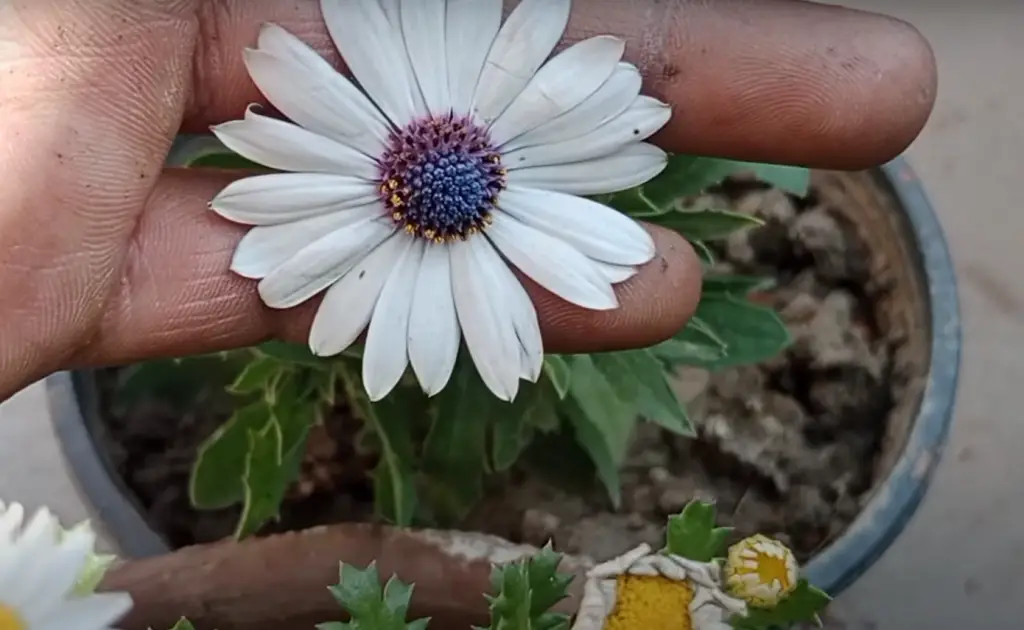
On the other hand, if it’s too alkaline, you can mix in some peat moss or compost to reduce pH levels. [2]
Daisy Planting Guidelines
- Plant daisies in full sun and well-drained soil.
- Space your plants 12 to 18 inches apart for larger varieties and 6 to 8 inches apart for smaller ones.
- Water your daisies regularly, giving them about an inch of water per week if there is no rain.
- Fertilise your plants every few months with a balanced fertiliser to encourage more blooms.
- Protect your daisies from heavy rains and strong winds by staking them or providing some shelter.
- In cold climates, cover your daisies with a layer of mulch in winter to protect them from frost.
Watering and Feeding Daisies
Water your daisies regularly throughout the season, making sure that they don’t get too dry. Aim to give them about an inch of water per week if there is no rain. You can also feed your daisies with a balanced fertiliser every few months to encourage more blooms.
Common Daisy Pests and Diseases
Daisies are generally hardy plants that can withstand most pests and diseases, but it’s still important to keep an eye out for any signs of trouble. Aphids, slugs, and snails can all be a problem for daisies in some cases, so be sure to check your plants regularly for signs of infestations.
Pruning and Overall Care
Regular deadheading of spent flowers will help prevent self-seeding and will encourage more blooms. For larger varieties, you may need to cut them back in late summer or early fall to keep them from getting too tall and leggy.
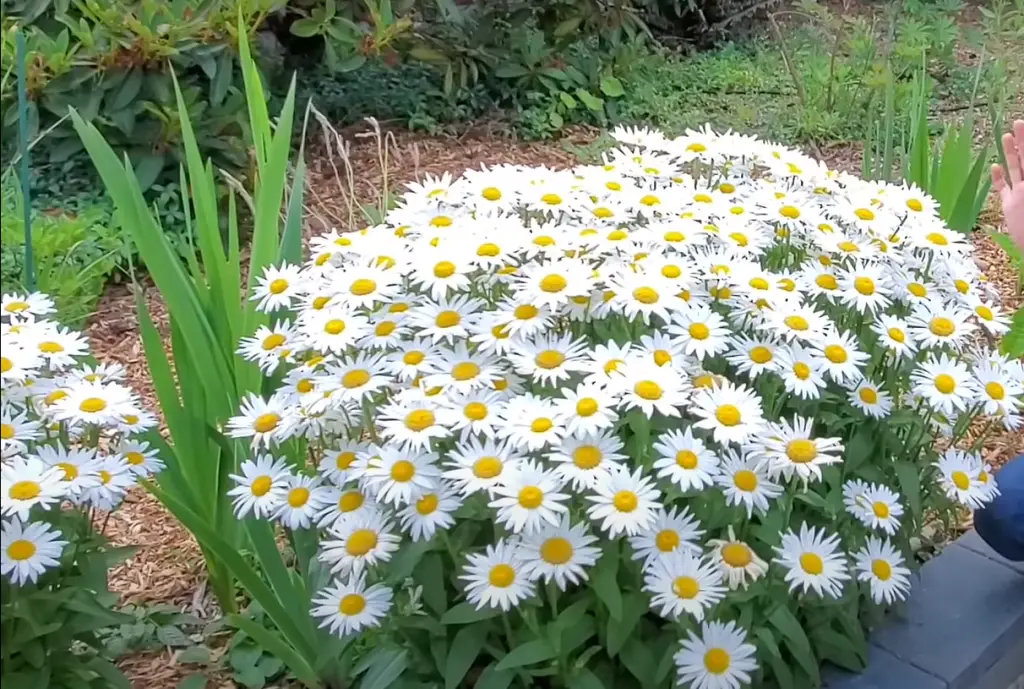
Overall, daisies require very little maintenance but keeping an eye out for pests and diseases is important.
FAQ
How do you take care of planted daisies?
To take care of planted daisies, water them regularly throughout the season, giving them about an inch of water per week if there is no rain. Fertilise them every few months with a balanced fertiliser to encourage more blooms.
Deadheads spent flowers on a regular basis to prevent self-seeding and promote new growth. Protect your daisies from heavy rains and strong winds by staking them or providing some shelter.
Check for signs of pests such as aphids, slugs, and snails and take appropriate measures to get rid of them. In cold climates, cover your daisies with a layer of mulch in winter to protect them from frost.
Are daisies easy to grow?
Yes, daisies are relatively easy to grow and require very little maintenance. They prefer sunny spots and well-drained soil that is slightly sweet and slightly acidic (pH 6.0–7.5). With the right care, your daisy plants should thrive in your garden for years to come.
Can I start my daisies from seed?
Yes, you can start your daisies from seed. Choose a spot for your daisies that is sunny and well-drained. Prepare the soil by loosening it with a rake or shovel and mix in some compost if needed.
Sow your daisy seeds about ¼ inch deep and cover them lightly with soil. Water them regularly and thin out seedlings as they grow, leaving space for larger varieties to spread out.
Can I transplant daisies?
Yes, you can transplant daisies that have already been established in your garden. Choose a sunny spot with well-drained soil and dig a hole twice the size of the root ball. Place your daisy plant in the hole, making sure that its roots are covered. Fill in around the roots with soil and press down firmly.
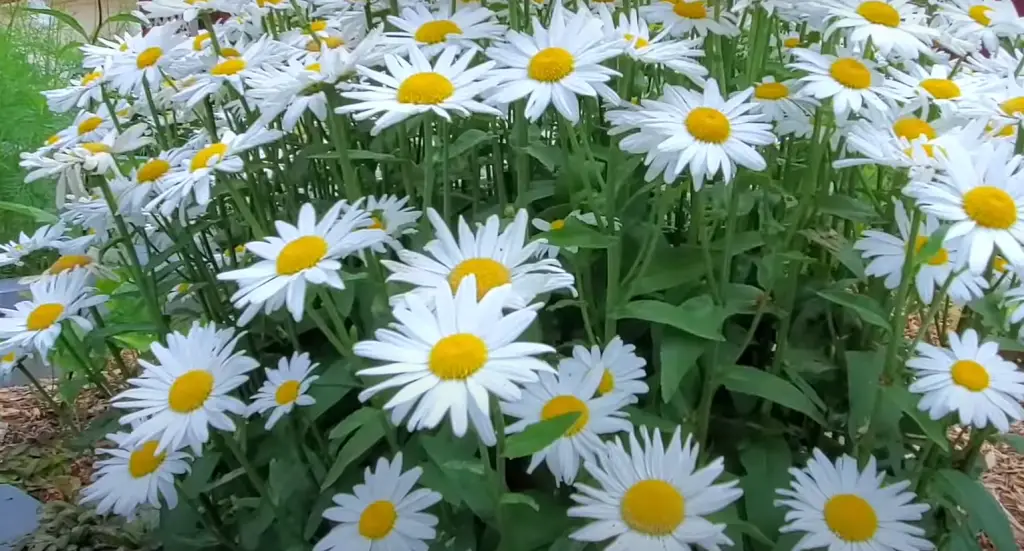
Water thoroughly after planting to help settle the soil and get rid of any air pockets. Mulch the area with a few inches of organic mulch to conserve moisture and discourage weeds.
How do you plant a daisy flower?
To plant a daisy flower, choose a sunny spot with well-drained soil and dig a hole twice the size of the root ball. Place your daisy plant in the hole, making sure that its roots are covered. Fill in around the roots with soil and press down firmly.
Water thoroughly after planting to help settle the soil and get rid of any air pockets.
Mulch the area with a few inches of organic mulch to conserve moisture and discourage weeds. Once your daisies are established in the garden, they require very little maintenance; just keep an eye out for any signs of pests or diseases and take appropriate measures to get rid of them.
Can you put daisies in a vase?
Yes, you can put daisies in a vase as long as they’re properly cared for. Place the stems of your daisies in fresh, cold water and cut off any leaves that will be submerged. Change the water every few days to keep it clean and fresh and add a drop of bleach or lemon juice to keep bacteria from growing on the stems. Trim off any dead or dying flowers and foliage to keep your daisies looking their best.
Can you grow daisies indoors?
Yes, it is possible to grow daisies indoors. Choose a bright spot that gets at least 4–6 hours of direct sunlight each day and use a potting mix that drains well. Water your daisies regularly and be sure to provide adequate air circulation by keeping the windows open or using a fan.
You may also want to give your indoor daisies a bit of fertiliser every few months to encourage more blooms.
How long do daisies take to grow?
Daisies typically take about 8–10 weeks to reach maturity and start blooming. To promote quick growth, choose a sunny spot with well-drained soil and make sure to water your daisies regularly throughout the season. Fertilise them every few months with a balanced fertiliser to encourage more blooms.
Keep an eye out for pests and diseases and take appropriate measures to get rid of them. With the right care, your daisies should grow quickly and provide you with plenty of blooms for years to come.
Are daisies easy to grow?
Yes, daisies are relatively easy to grow and require very little maintenance.
Daisies typically take about 8–10 weeks to reach maturity and start blooming, but with the right care, they should thrive in your garden for years to come.
Regular deadheading of spent flowers, protecting them from strong winds and heavy rains, and checking them regularly for pests will all help ensure that your daisies stay healthy and happy.
Are daisies indoor or outdoor plants?
Daisies are typically grown outdoors in sunny spots with well-drained soil but they can also be grown indoors as long as the spot gets at least 4–6 hours of direct sunlight each day.

When growing daisies indoors, make sure to provide adequate air circulation by keeping the windows open or using a fan and fertilising them every few months with a balanced fertiliser to encourage more blooms.
Can you grow daisies in containers?
Yes, you can grow daisies in containers as long as they are large enough to accommodate their root systems. Choose a spot for your container that gets at least 4–6 hours of direct sunlight each day and use a potting mix that drains well.
Water your daisies regularly, fertilise them every few months with a balanced fertiliser to encourage more blooms, and check for signs of pests such as aphids, slugs, and snails.
What’s the best way to care for my daisies?
The best way to care for your daisies is to choose a sunny spot with well-drained soil and water them regularly throughout the season. Fertilise your daisies every few months with a balanced fertiliser to encourage more blooms and check for signs of pests or diseases and take appropriate measures to get rid of them.
Deadheads spend flowers regularly and protect your daisies from strong winds and heavy rains.
What pests or diseases should I look out for?
When caring for your daisies, keep an eye out for signs of pests such as aphids, slugs, and snails. These can be controlled with insecticidal soaps or horticultural oils.
Fungal diseases such as powdery mildew, rust, and leaf spot can also affect your daisies; these can usually be managed with a combination of good air circulation and fungicides. If you notice any signs of pests or diseases, take appropriate measures to get rid of them as quickly as possible.
What types of daisies are there?
There are many different types of daisies, including garden varieties like Shasta, English, and African daisies as well as wildflower species such as Oxeye Daisy and Common Daisy.
Each type has its own unique characteristics in terms of flower shape and size, growth habit, etc., so it’s important to choose the right type for your garden.
Most types of daisies are easy to grow and require very little maintenance; however, some may be more susceptible to pests or diseases than others, so it’s important to keep an eye out for any signs of trouble.
How do I propagate daisies?
Daisies can be propagated by seed or division. To propagate by seed, choose a sunny spot with well-drained soil and sow the seeds in late summer or early autumn. Once they have germinated, thin out any overcrowded plants and water them regularly throughout the season.
To propagate by division, wait until the daisies have finished blooming and carefully dig up the clumps of plants. Gently separate them into smaller chunks with a sharp knife and replant them in the desired location.
Water your new daisy plants regularly throughout the season to ensure they become established.
How can I make my daisies look their best?
To keep your daisies looking their best, deadhead any spent flowers and trim off any dead or dying foliage. Make sure to water them regularly throughout the season and fertilise them every few months with a balanced fertiliser to encourage more blooms. Keep an eye out for pests and diseases and take appropriate measures to get rid of them.
How can I use daisies in my garden?
Daisies are a great choice for any garden, as they add colour and texture to the landscape. They make excellent cut flowers and look beautiful planted in mass groupings or mixed with other plants such as perennials or grasses.
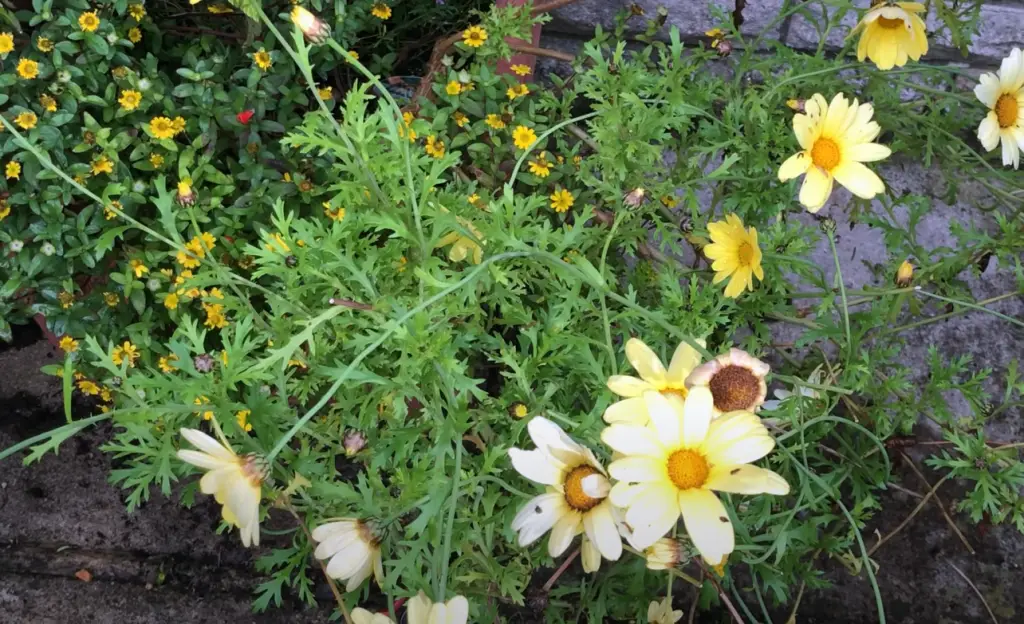
Daisies also attract bees and other pollinators, so they’re a great choice for gardens that are trying to support wildlife. With the right care, your daisies should provide you with plenty of blooms for years to come.
How long do daisies last?
Daisies typically last for several years if they are given the right care. Choose a sunny spot with well-drained soil and water your daisies regularly throughout the season.
Fertilise them every few months with a balanced fertiliser to encourage more blooms and keep an eye out for pests or diseases and take appropriate measures to get rid of them. With the right care, your daisies should provide you with plenty of blooms for years to come.
How do I preserve daisies?
If you would like to preserve your daisies, the best way is to press them between two sheets of paper and place them in a book. Alternatively, you can use a flower press or freeze-dry them for long-term preservation.
Once the daisies have been pressed or freeze-dried, you can arrange them in a frame or use them to make potpourri. Preserving your daisies is a great way to enjoy their beauty for years to come.
Does deadheading daisies help them bloom more?
Yes, deadheading your daisies will help them to produce more blooms. When you deadhead flowers, it redirects the plant’s energy into producing new buds and encourages further flowering.
Deadheading should be done regularly throughout the season to ensure that your daisies are always looking their best.
Do daisies need to be pruned?
Daisies do not typically require pruning, but it can help to keep them looking their best. Prune any dead or dying foliage in late winter or early spring and trim back any overgrown plants after flowering has finished. Pruning your daisies will encourage bushier growth and more blooms in the following season.
What can I do with daisy seeds?
Daisy seeds can be used to create a variety of interesting projects. They can be used to make jewellery, potpourri, flower garlands, or decorations for clothing or other items.
If you’re feeling adventurous, you could even try your hand at growing your own daisies from seed! With a bit of care and patience, you should be able to enjoy the beauty of daisies in your garden for years to come.
Useful Video: Top secret tips for daisy flower plant || How to grow and care daisy flower plant.
Conclusion
It can be a bit intimidating to take on the challenge of caring for daisy flowers at first, however with a good plan and understanding of how to care for them, the process becomes much more manageable! You will need to ensure that your soil is well prepared, that you choose the right variety of daisies, and provide adequate amounts of water and sunlight.
With a few simple steps, you’ll have beautiful blooms in your garden that will last for years to come. Be sure to monitor your daisies regularly and take appropriate action when necessary. Taking careful care of these elegant blooms will undoubtedly lead to an incredible outdoor space full of life and colour!
References:
- https://www.masterclass.com/articles/daisy-care-guide
- https://kellogggarden.com/blog/gardening/how-to-plant-grow-and-care-for-daisy-flowers/










Leave a Reply
View Comments